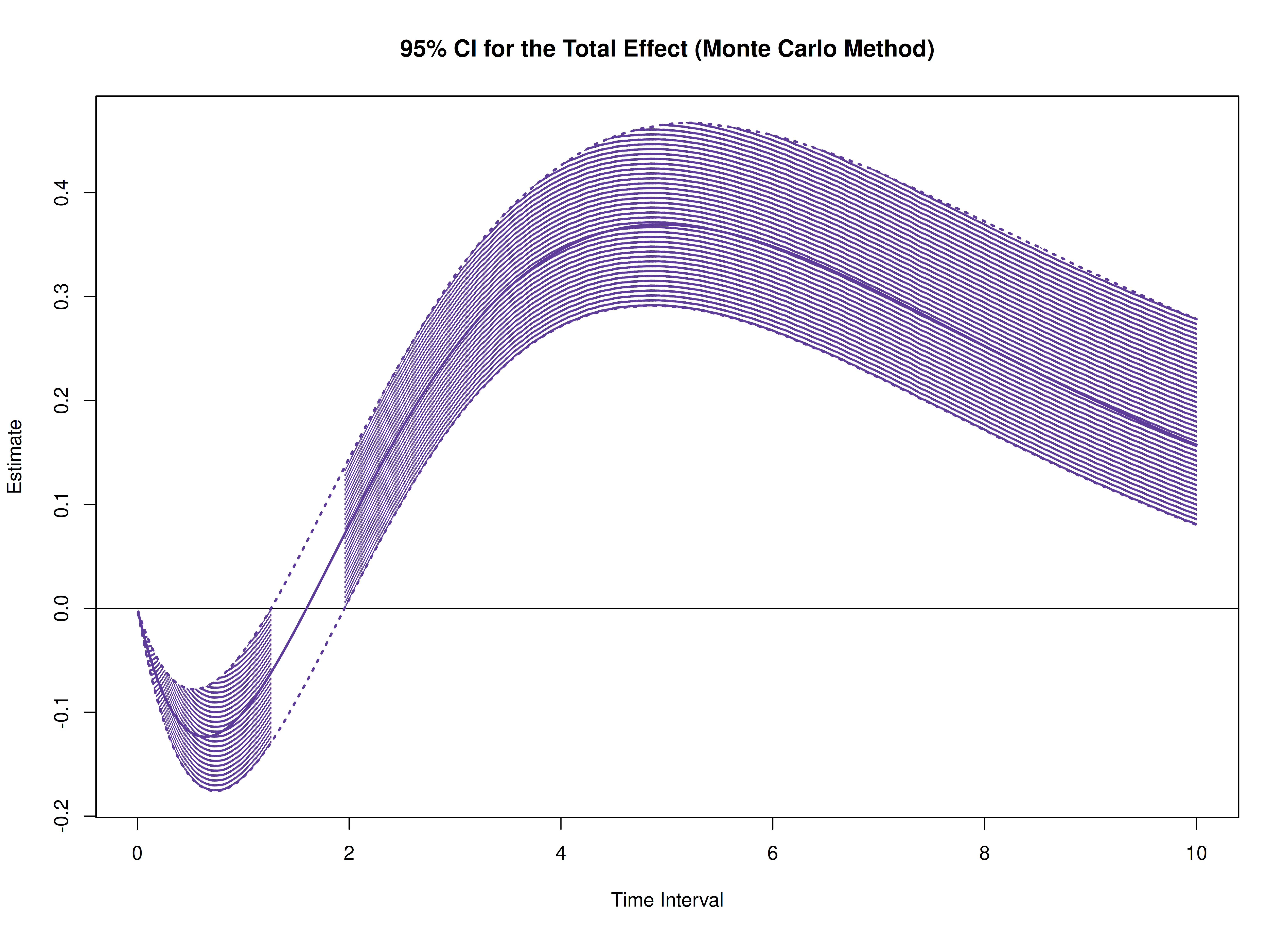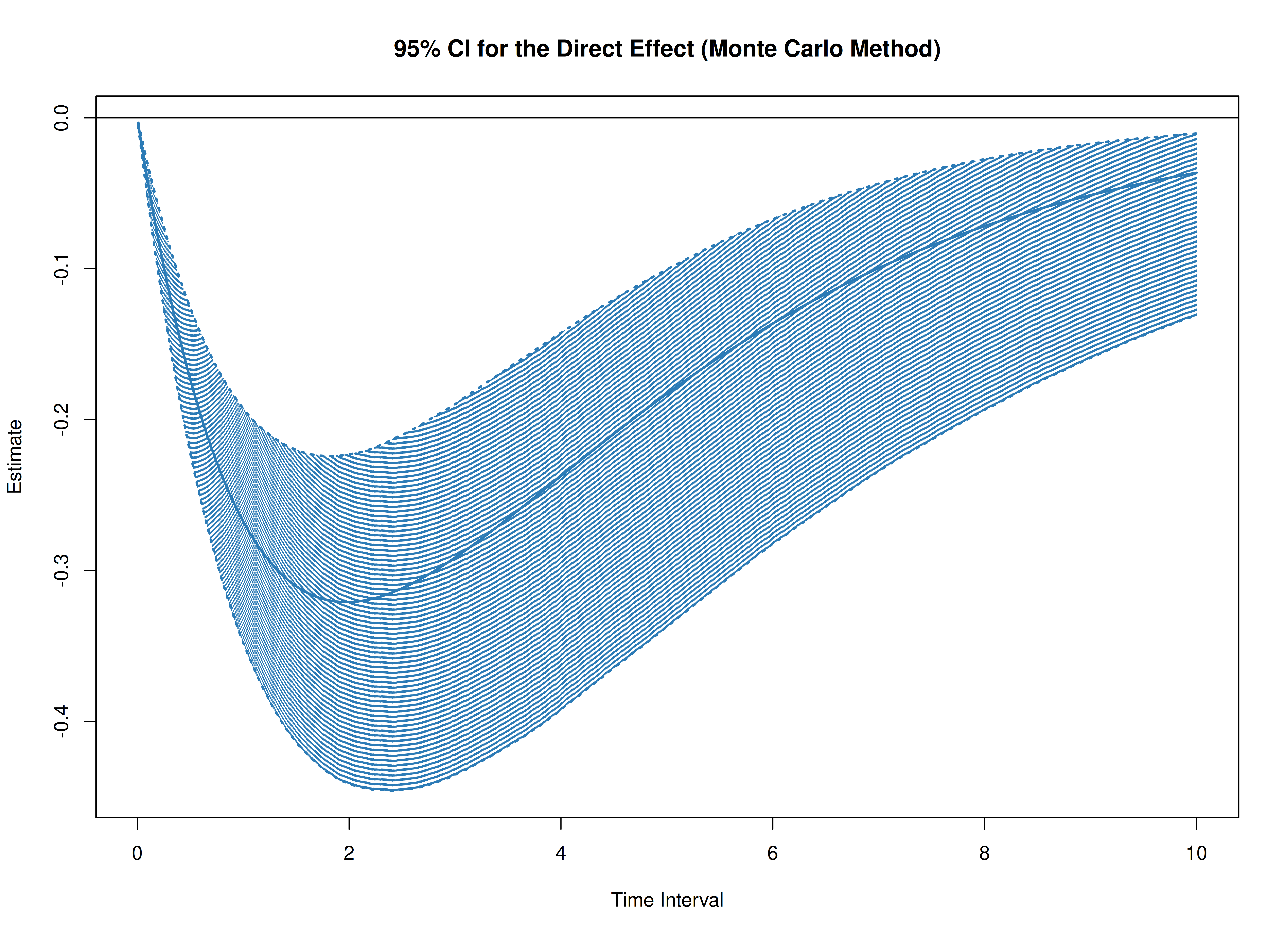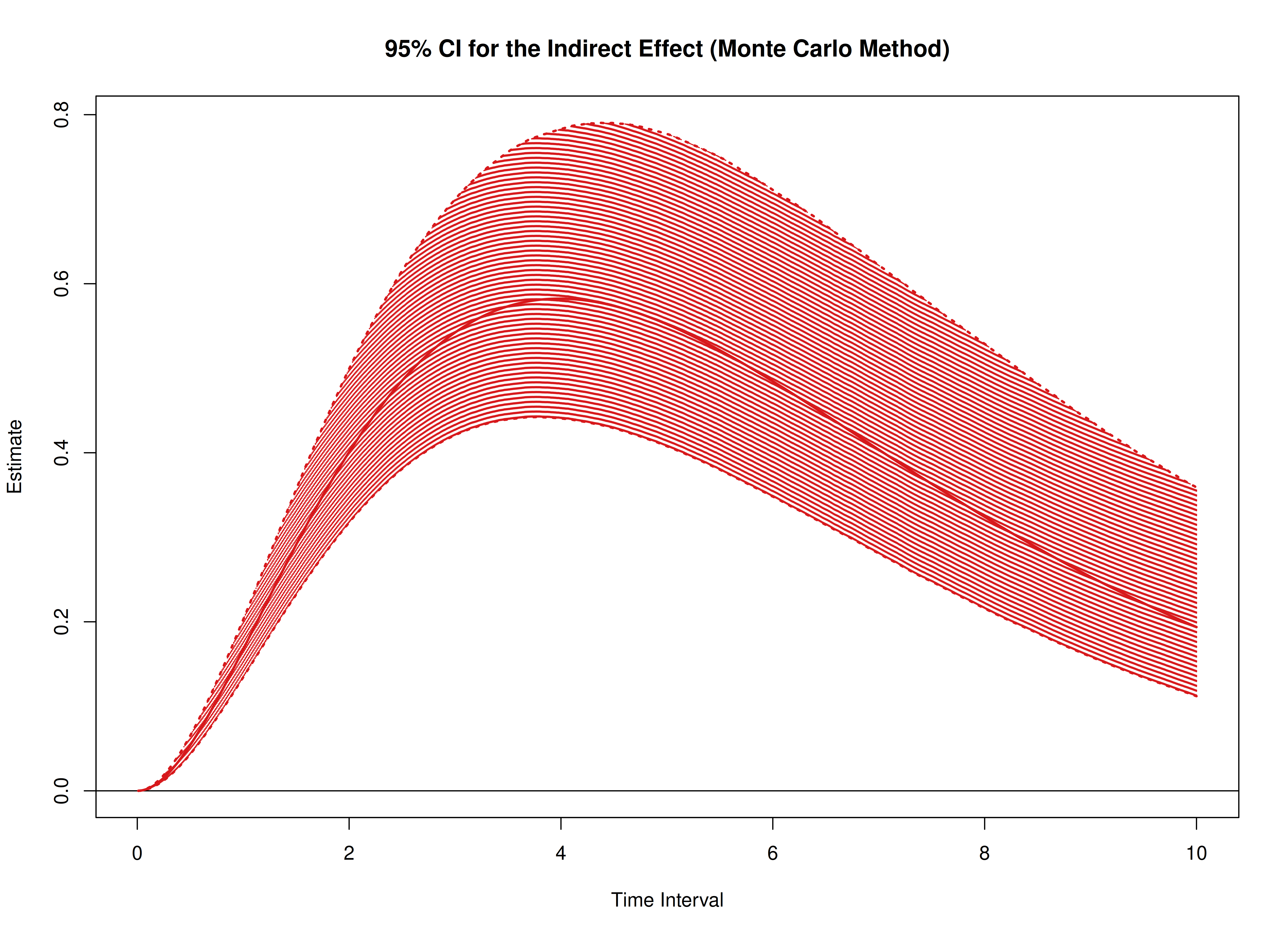Total, Direct, and Indirect Effects in Continuous-Time Mediation Model
Ivan Jacob Agaloos Pesigan
2025-10-19
Source:vignettes/med.Rmd
med.RmdThe cTMed package offers tools for estimating and
quantifying uncertainty in total, direct, and indirect effects within
continuous-time mediation models across various time intervals using the
delta and Monte Carlo methods. To implement these approaches, estimates
from a continuous-time vector autoregressive (CT-VAR) model are
required, particularly the drift matrix and its corresponding sampling
variance-covariance matrix. For guidance on fitting CT-VAR models using
the dynr or OpenMx packages, refer to Fit
the Continuous-Time Vector Autoregressive Model Using the dynr
Package and Fit
the Continuous-Time Vector Autoregressive Model Using the OpenMx
Package, respectively.
summary(fit)
#> Coefficients:
#> Estimate Std. Error t value ci.lower ci.upper Pr(>|t|)
#> phi_1_1 -0.3518738 0.0345599 -10.182 -0.4196100 -0.2841377 <2e-16 ***
#> phi_2_1 0.7442754 0.0213025 34.938 0.7025233 0.7860275 <2e-16 ***
#> phi_3_1 -0.4586681 0.0224194 -20.459 -0.5026093 -0.4147269 <2e-16 ***
#> phi_1_2 0.0173316 0.0304068 0.570 -0.0422645 0.0769278 0.2843
#> phi_2_2 -0.4888138 0.0188377 -25.949 -0.5257350 -0.4518927 <2e-16 ***
#> phi_3_2 0.7267855 0.0198254 36.659 0.6879284 0.7656426 <2e-16 ***
#> phi_1_3 -0.0238213 0.0233767 -1.019 -0.0696387 0.0219962 0.1541
#> phi_2_3 -0.0098181 0.0144220 -0.681 -0.0380848 0.0184485 0.2480
#> phi_3_3 -0.6883228 0.0152967 -44.998 -0.7183038 -0.6583418 <2e-16 ***
#> sigma_1_1 0.2421847 0.0064484 37.557 0.2295461 0.2548232 <2e-16 ***
#> sigma_2_1 0.0232727 0.0025183 9.241 0.0183369 0.0282084 <2e-16 ***
#> sigma_3_1 -0.0505753 0.0026989 -18.739 -0.0558649 -0.0452856 <2e-16 ***
#> sigma_2_2 0.0707197 0.0018899 37.420 0.0670155 0.0744238 <2e-16 ***
#> sigma_3_2 0.0149893 0.0013541 11.070 0.0123354 0.0176433 <2e-16 ***
#> sigma_3_3 0.0723762 0.0020868 34.683 0.0682861 0.0764663 <2e-16 ***
#> theta_1_1 0.1988610 0.0011588 171.608 0.1965898 0.2011323 <2e-16 ***
#> theta_2_2 0.1995204 0.0009996 199.609 0.1975613 0.2014795 <2e-16 ***
#> theta_3_3 0.2011716 0.0010145 198.288 0.1991832 0.2031601 <2e-16 ***
#> mu0_1_1 0.0062149 0.1219710 0.051 -0.2328439 0.2452737 0.4797
#> mu0_2_1 -0.0425006 0.1208284 -0.352 -0.2793200 0.1943187 0.3625
#> mu0_3_1 0.1300648 0.1041761 1.249 -0.0741167 0.3342462 0.1059
#> sigma0_1_1 1.1504264 0.1810442 6.354 0.7955863 1.5052665 <2e-16 ***
#> sigma0_2_1 0.4136629 0.1418008 2.917 0.1357384 0.6915875 0.0018 **
#> sigma0_3_1 0.2260142 0.1187792 1.903 -0.0067889 0.4588172 0.0285 *
#> sigma0_2_2 1.2218038 0.1985814 6.153 0.8325914 1.6110161 <2e-16 ***
#> sigma0_3_2 0.2353104 0.1267133 1.857 -0.0130432 0.4836640 0.0317 *
#> sigma0_3_3 0.9626701 0.1594441 6.038 0.6501655 1.2751747 <2e-16 ***
#> ---
#> Signif. codes: 0 '***' 0.001 '**' 0.01 '*' 0.05 '.' 0.1 ' ' 1
#>
#> -2 log-likelihood value at convergence = 429365.49
#> AIC = 429419.49
#> BIC = 429676.34
phi_varnames <- c(
"phi_1_1",
"phi_2_1",
"phi_3_1",
"phi_1_2",
"phi_2_2",
"phi_3_2",
"phi_1_3",
"phi_2_3",
"phi_3_3"
)
phi <- matrix(
data = coef(fit)[phi_varnames],
nrow = 3,
ncol = 3
)
colnames(phi) <- rownames(phi) <- c("x", "m", "y")
vcov_phi_vec <- vcov(fit)[phi_varnames, phi_varnames]
# Drift matrix
phi
#> x m y
#> x -0.3518738 0.01733165 -0.023821271
#> m 0.7442754 -0.48881381 -0.009818147
#> y -0.4586681 0.72678550 -0.688322785
# Sampling variance-covariance matrix
vcov_phi_vec
#> phi_1_1 phi_2_1 phi_3_1 phi_1_2 phi_2_2
#> phi_1_1 1.194386e-03 9.434520e-05 -1.832722e-04 -1.004483e-03 -8.964831e-05
#> phi_2_1 9.434520e-05 4.537958e-04 -4.543459e-06 -6.913945e-05 -3.836601e-04
#> phi_3_1 -1.832722e-04 -4.543459e-06 5.026282e-04 1.483225e-04 1.026409e-05
#> phi_1_2 -1.004483e-03 -6.913945e-05 1.483225e-04 9.245720e-04 7.282409e-05
#> phi_2_2 -8.964831e-05 -3.836601e-04 1.026409e-05 7.282409e-05 3.548578e-04
#> phi_3_2 1.607647e-04 -2.804753e-06 -4.250983e-04 -1.450161e-04 -2.919274e-06
#> phi_1_3 6.774418e-04 4.293486e-05 -9.128814e-05 -6.468942e-04 -4.622427e-05
#> phi_2_3 7.077153e-05 2.572020e-04 -1.302596e-05 -6.094418e-05 -2.476033e-04
#> phi_3_3 -1.143637e-04 6.496454e-06 2.868236e-04 1.076101e-04 -3.253344e-06
#> phi_3_2 phi_1_3 phi_2_3 phi_3_3
#> phi_1_1 1.607647e-04 6.774418e-04 7.077153e-05 -1.143637e-04
#> phi_2_1 -2.804753e-06 4.293486e-05 2.572020e-04 6.496454e-06
#> phi_3_1 -4.250983e-04 -9.128814e-05 -1.302596e-05 2.868236e-04
#> phi_1_2 -1.450161e-04 -6.468942e-04 -6.094418e-05 1.076101e-04
#> phi_2_2 -2.919274e-06 -4.622427e-05 -2.476033e-04 -3.253344e-06
#> phi_3_2 3.930470e-04 9.435689e-05 8.776401e-06 -2.762247e-04
#> phi_1_3 9.435689e-05 5.464686e-04 4.564710e-05 -8.808095e-05
#> phi_2_3 8.776401e-06 4.564710e-05 2.079953e-04 -1.947278e-06
#> phi_3_3 -2.762247e-04 -8.808095e-05 -1.947278e-06 2.339894e-04In this example, we aim to calculate the total, direct, and indirect
effects of x on y, mediated through
m, over time intervals ranging from 0 to 10.
# time intervals
delta_t <- seq(from = 0, to = 10, length.out = 1000)Delta Method
library(cTMed)
start <- Sys.time()
delta <- DeltaMed(
phi = phi,
vcov_phi_vec = vcov_phi_vec,
delta_t = delta_t,
from = "x",
to = "y",
med = "m",
ncores = parallel::detectCores() # use multiple cores
)
end <- Sys.time()
elapsed <- end - start
elapsed
#> Time difference of 0.8812237 secs
plot(delta)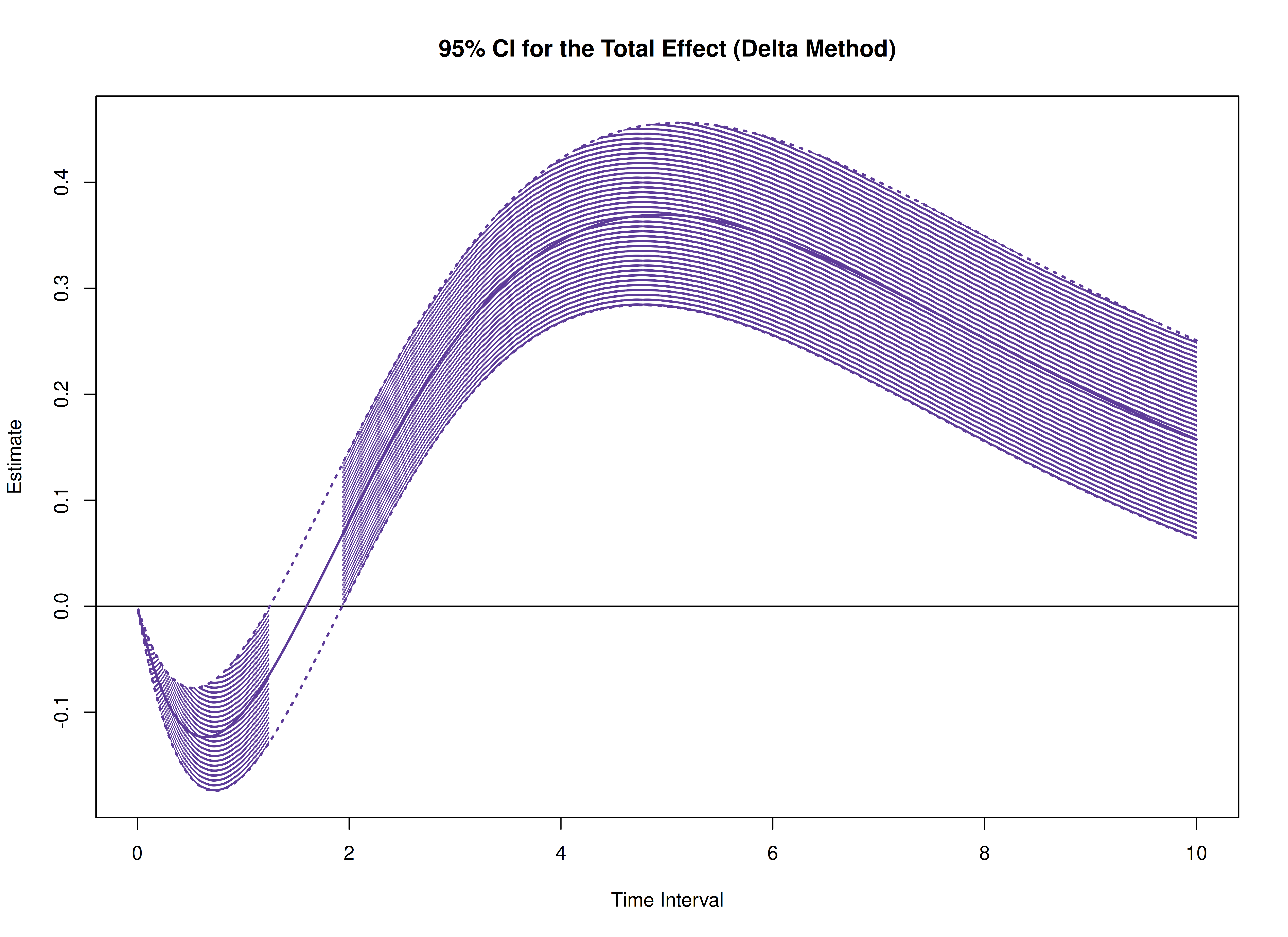
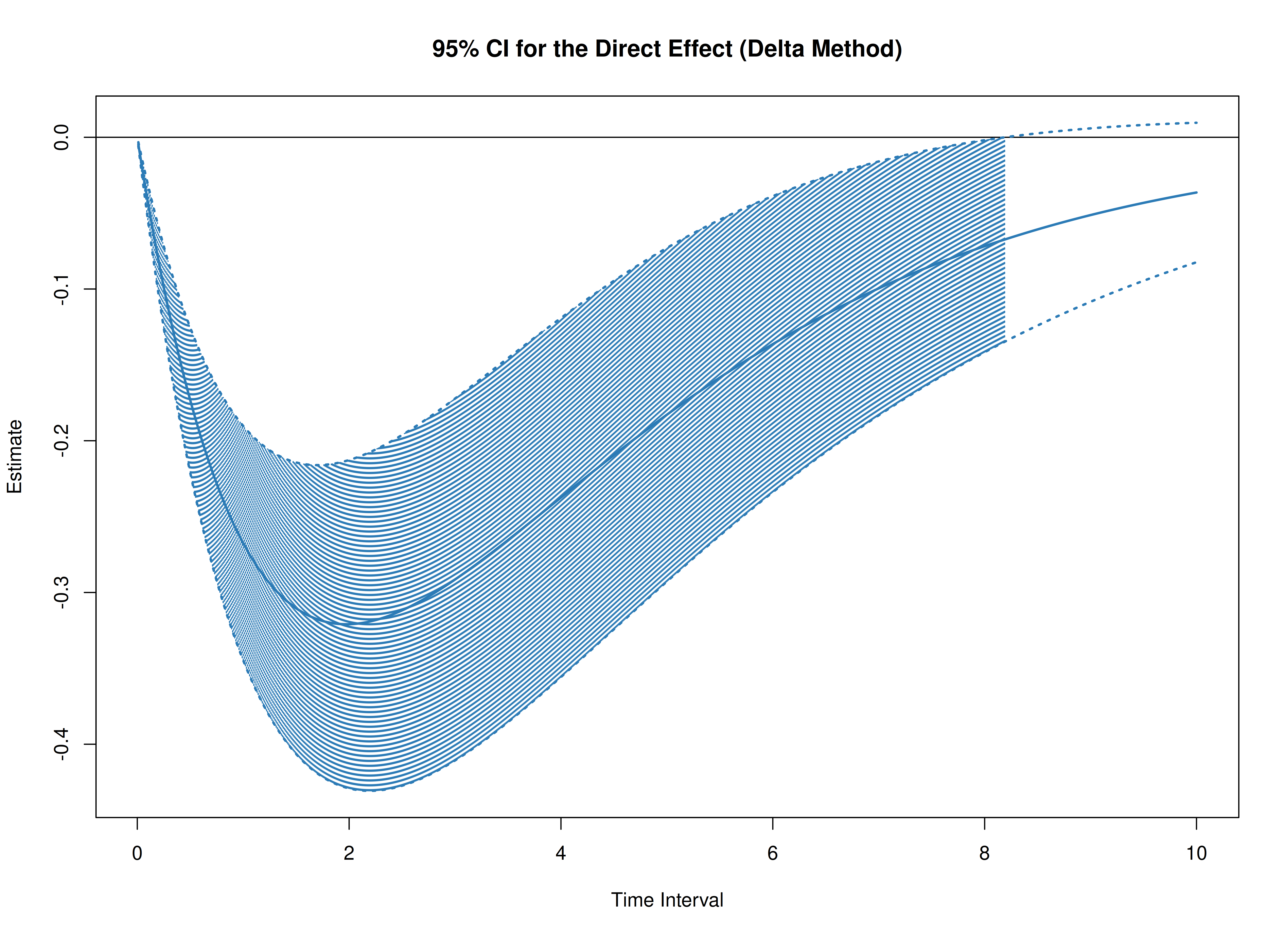
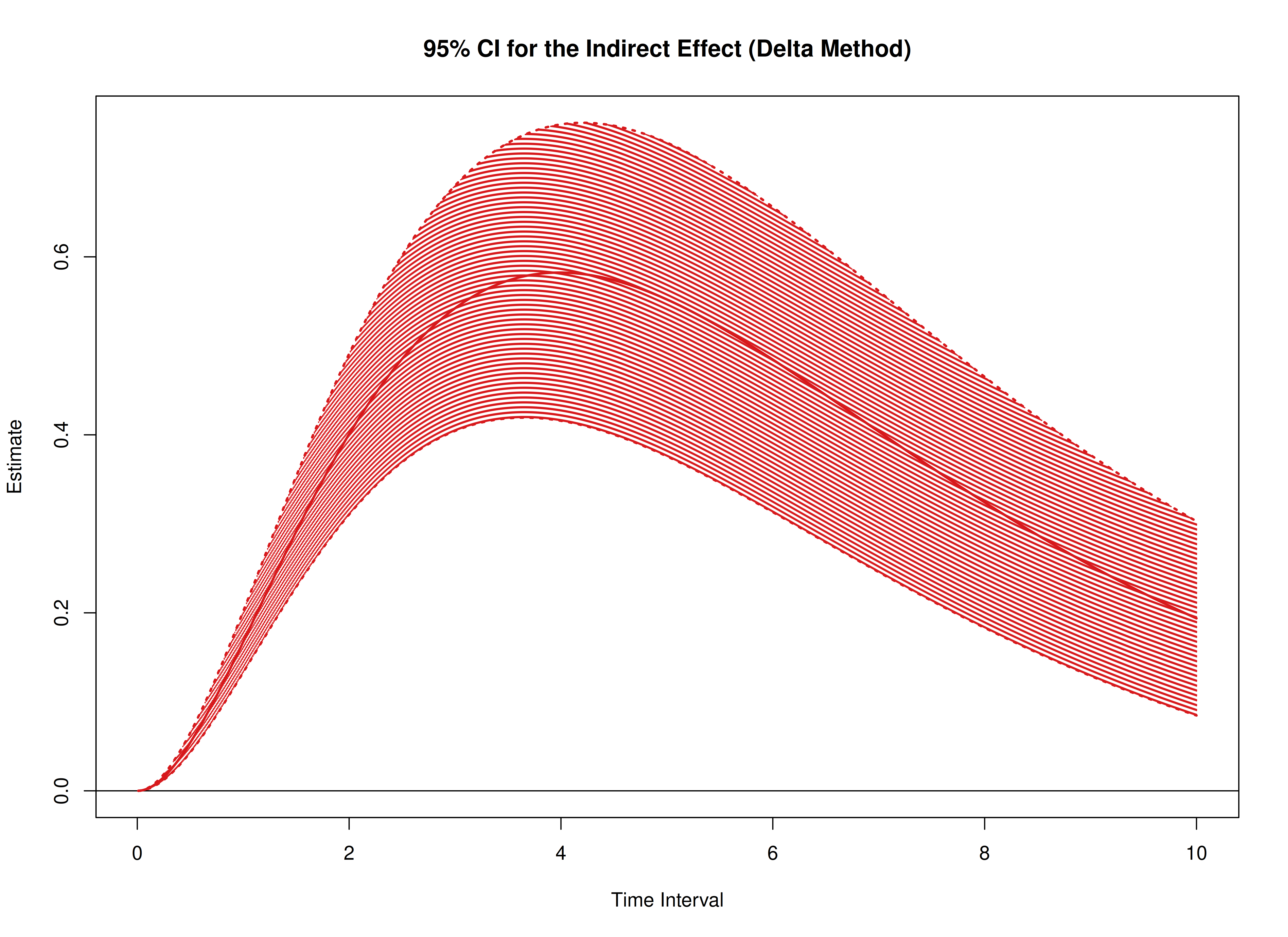
Monte Carlo Method
start <- Sys.time()
mc <- MCMed(
phi = phi,
vcov_phi_vec = vcov_phi_vec,
delta_t = delta_t,
from = "x",
to = "y",
med = "m",
R = 20000L,
ncores = parallel::detectCores() # use multiple cores
)
end <- Sys.time()
elapsed <- end - start
elapsed
#> Time difference of 16.84048 mins
plot(mc)